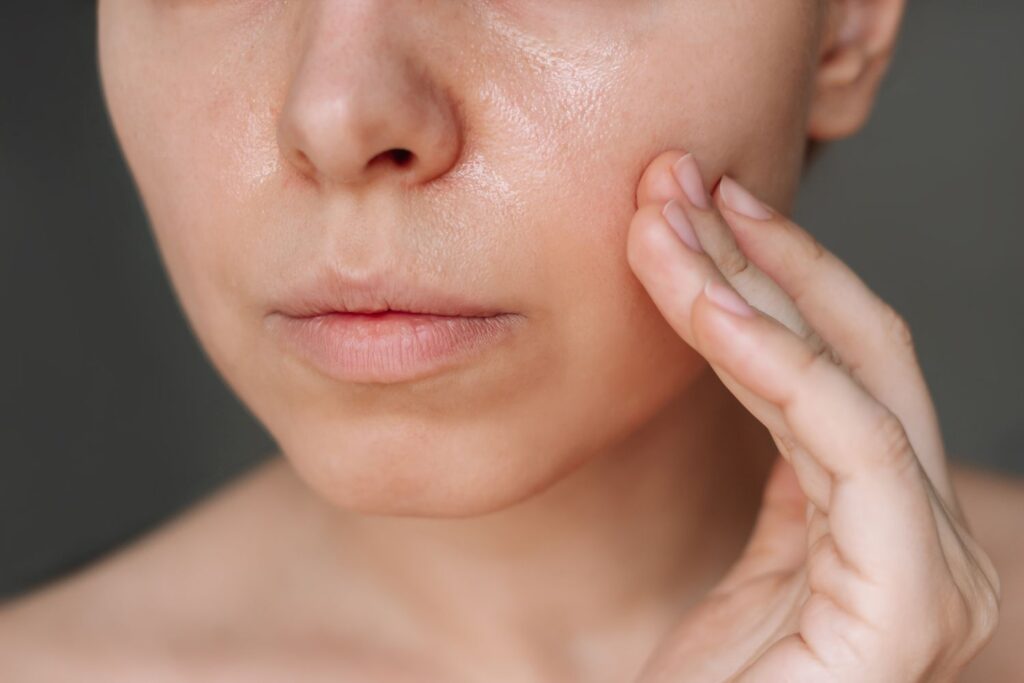Oily skin is characterized by overproduction of sebum, a natural oil secreted by the sebaceous glands. While sebum is essential for skin hydration and barrier function, excessive amounts can lead to a greasy appearance, enlarged pores, and an increased likelihood of acne and blackheads. Individuals with oily skin often struggle to maintain a fresh, matte finish and may experience breakouts due to clogged pores.

Causes of Oily Skin: Internal and External Factors
1. Genetics
Sebum production is largely genetically determined. If one or both parents have oily skin, there’s a high probability that their offspring will too.
2. Hormonal Changes
Fluctuations in androgen levels—common during puberty, menstruation, pregnancy, or menopause—stimulate sebaceous gland activity.
3. Climate and Weather
Hot and humid conditions exacerbate oil production, leading to shinier skin and higher risk of acne formation.
4. Improper Skincare Practices
Over-cleansing, skipping moisturizer, or using harsh products can strip natural oils and trigger rebound oil production.
5. Diet and Lifestyle
High-glycemic diets, dairy intake, lack of sleep, and stress can contribute to hormonal imbalances and worsen oiliness.
Identifying Oily Skin: Signs and Common Concerns
- Persistent shine, especially in the T-zone (forehead, nose, chin)
- Noticeably large and visible pores
- Makeup slides off or oxidizes quickly
- Frequent blackheads, whiteheads, and breakouts
- Skin feels greasy within hours of cleansing
Daily Skincare Routine for Oily Skin
Morning Routine
1. Gentle Cleanser (Low pH, Non-Comedogenic)
Use a foaming or gel-based cleanser containing salicylic acid or tea tree oil to remove excess oil without stripping the skin.
2. Toner with Astringent Properties
Choose alcohol-free toners with witch hazel, niacinamide, or green tea extract to minimize pores and reduce oiliness.
3. Oil-Free Moisturizer
Hydration is essential, even for oily skin. Use gel-based or water-based moisturizers containing hyaluronic acid.
4. Broad-Spectrum Sunscreen (SPF 30 or Higher)
Opt for matte-finish or mineral sunscreens with zinc oxide or titanium dioxide.
Evening Routine
1. Double Cleansing (Oil + Water-Based)
Begin with a non-comedogenic cleansing oil to dissolve sunscreen and makeup, followed by a foaming cleanser.
2. Exfoliation (2–3 Times Weekly)
Incorporate chemical exfoliants like BHA (salicylic acid) to unclog pores and prevent blackheads.
3. Treatment Serums
- Niacinamide: Regulates oil and brightens skin
- Retinoids: Controls sebum and prevents acne
- Azelaic Acid: Combats inflammation and pigmentation
4. Night Moisturizer or Lightweight Gel
Finish with a non-greasy moisturizer to repair the skin barrier overnight.
Recommended Ingredients for Oily Skin
| Ingredient | Function |
|---|---|
| Salicylic Acid | Penetrates pores to dissolve oil and debris |
| Niacinamide | Regulates sebum and refines pores |
| Zinc PCA | Controls shine and soothes inflammation |
| Retinol | Reduces oiliness and improves cell turnover |
| Clay (Kaolin/Bentonite) | Absorbs excess oil and detoxifies skin |
| Tea Tree Oil | Antibacterial and anti-inflammatory |
Professional Treatments for Persistent Oiliness
1. Chemical Peels
Mild peels containing salicylic or glycolic acid can exfoliate dead cells and reduce oil production over time.
2. Laser and Light Therapies
Intense Pulsed Light (IPL) and laser treatments shrink sebaceous glands and improve texture.
3. Microneedling with Radiofrequency
Reduces pore size and oiliness by stimulating collagen production.
4. Prescription Medications
For severe cases, dermatologists may prescribe oral retinoids (isotretinoin) or hormonal therapies to regulate oil.
Common Myths About Oily Skin
- “Oily skin doesn’t need moisturizer.”
Skipping moisturizer can worsen oiliness by prompting compensatory sebum production. - “Washing your face frequently controls oil.”
Overwashing strips the skin and triggers excess oil secretion. - “Oily skin doesn’t age.”
While sebum may delay wrinkles, oily skin is still prone to other aging signs like enlarged pores and dullness.
Lifestyle and Dietary Tips for Managing Oily Skin
- Hydrate adequately with water-rich foods and fluids.
- Reduce sugar and dairy intake which may trigger hormonal imbalance.
- Sleep 7–9 hours nightly to support skin regeneration.
- Practice stress management through yoga, meditation, or exercise.
- Change pillowcases frequently to prevent buildup of oil and bacteria.
Best Products for Oily Skin: Essentials to Look For
| Product Type | Recommended Features |
|---|---|
| Cleanser | Gel-based, non-comedogenic, salicylic acid |
| Moisturizer | Oil-free, hyaluronic acid, gel-cream texture |
| Sunscreen | Mineral, matte-finish, broad-spectrum SPF 30+ |
| Face Mask | Clay or charcoal-based for oil absorption |
| Serum | Niacinamide or zinc-infused for oil regulation |
Frequently Asked Questions
Q1: What causes oily skin on the face?
Overactive sebaceous glands, often influenced by genetics, hormones, or environmental factors, are the primary cause.
Q2: Is oily skin bad?
Not inherently. While it can lead to acne, oily skin also provides natural moisture and may slow aging.
Q3: Can oily skin be permanently cured?
No, but it can be effectively managed with the right skincare, diet, and treatments.
Q4: Should I use toner if I have oily skin?
Yes, a gentle, alcohol-free toner helps balance oil and refine pores.
Q5: Does drinking water reduce oily skin?
Proper hydration helps regulate overall skin health but doesn’t directly decrease oil production.
Managing oily skin requires a strategic balance of effective cleansing, lightweight hydration, and targeted treatments. By understanding the underlying causes and implementing a consistent skincare regimen tailored to oily skin, individuals can achieve clearer, healthier, and more balanced complexions. Incorporating professional guidance and lifestyle adjustments further enhances long-term skin resilience and oil control.